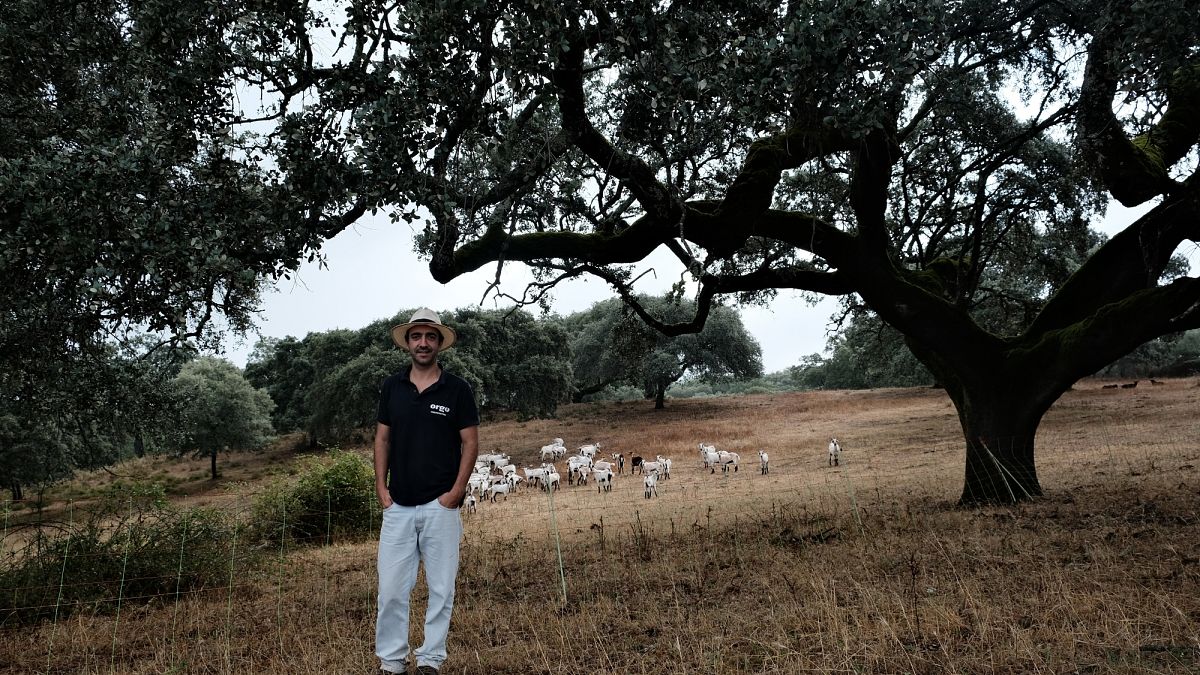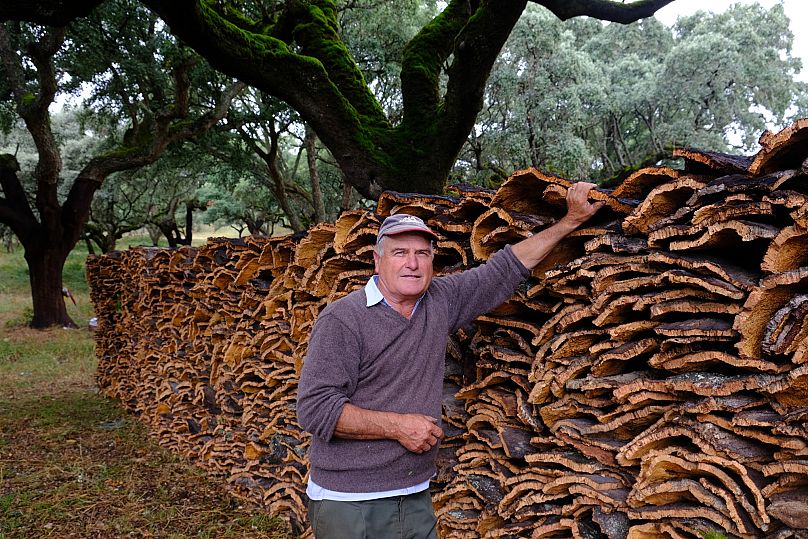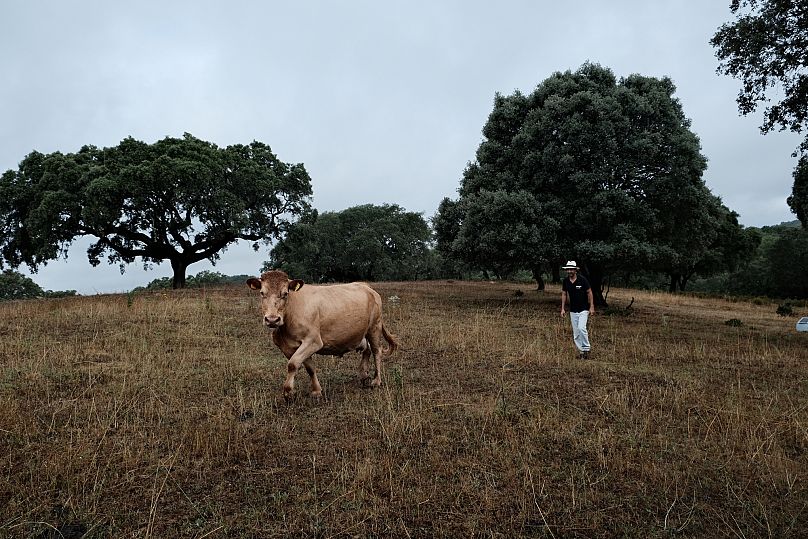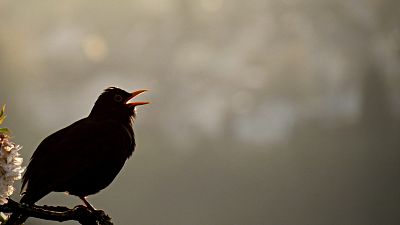A regenerative grazing project adapts Portugal’s ancient agrosilvopastoral system of Montado to help boost soil health and support biodiversity
In the gently undulating hills of Alentejo, black Iberian pigs and Merino sheep graze under old holm oak trees at Herdade S. Luís.
Nearby, Serpentina goats nibble on brambles and remove the undergrowth of flammable grasses. They are helping prevent fire just before the peak of summer when the hills turn tinder-dry and temperatures can rise up to 45C in southern Portugal.
While the pigs, goats and sheep are busy nibbling, jays and hoopoes fly over the estate’s thousands of trees, and José Mendes piles up cork planks recently extracted from the 700-hectare oak groves.
Every summer, he swings his axe and then carefully peels away the outer layer of the bark of cork oaks without harming the trees - a skill he has mastered over more than four decades as a cork cutter.
“What I like the most is seeing these beautiful old trees,” says Mendes as he stands under the sprawling branches.
He is hired between May and August each year to extract cork when the trees are in their active phase of growth.
Once the cork is removed, it slowly grows back. It can be harvested every nine years, on average about 15 times in each tree’s two hundred year lifespan. When they become old or fragile they get to “retire” from cork extraction but continue to produce acorns and provide shade to the farm’s animals.
“Many of the cork and holm oaks here are over two centuries old, they’ve been managed by my family for many generations,” says Francisco Alves, the property’s owner.
Producing food in a warming and drying climate
Herdade de S. Luís is part of the vast estates of Montado, an ancient cultural landscape rolling from the hills down to the plains of Alentejo that combines trees with livestock and crops.
“Montado is the perfect system because it allows us to integrate different land uses,” says Alves.
“The animals help prevent fires and can fertilise the soil. They feed on acorns, and also benefit from the shade of oak trees.”
Like most of the Mediterranean region, southern Portugal is experiencing worsening drought and desertification. In Alentejo, soils are poor and there is often no rain for nine months.
But the system of Montado is able to create abundance even in conditions of scarcity.
“It’s a way of using the land that respects existing resources,” says Teresa Pinto-Correia, a professor at the University of Évora focusing on rural landscapes and agricultural systems.
“It’s a very rich ecosystem, where biodiversity is maintained but at the same time it’s a productive system.”
Shaped by human activity for pastures and cork, it can also produce acorns, fruits, honey and mushrooms.
The Montado is included in the European Union Habitats Directive and is considered a High-Nature-Value-Farmland that supports hundreds of species, including the endangered Iberian Lynx and the threatened Imperial Eagle.
Interspersing trees adapted to the dry lands, animals and crops can boost food production but also build soil, regulate water cycles, protect against erosion, increase biodiversity and sequester carbon.
Regenerative grazing
Alves is not only carrying on the centuries-old tradition of Montado. He is also combining it with more recent regenerative techniques to boost soil health in his fields and produce better quality food.
At Herdade de S. Luís no chemicals are used and there is no ploughing to avoid disturbing the soil.
Alves closely manages where and for how long animals forage and their effect on the land. He uses electric fencing to restrict them to one section of the field at a time. Here they graze for a few days, deposit manure and are then moved onto a fresh patch. Moving the pasture to new plots allows the grazed land time to recover.
“Animals shouldn’t be grazing the same pasture continuously, because this leads to soil degradation,” he explains, adding that this system of multi-species regenerative grazing is designed to mimic the way herbivores move through the landscape.
He adjusts the movement of his herds to make sure grazing is done in a sustainable way that keeps the soil healthy.
Studies have found that, if managed carefully to prevent overgrazing, extensive pastures can stimulate plant growth, help spread seeds, reduce soil erosion and improve water retention.
Alves says the regenerative methods are improving not just soil health, but animal welfare too. Grazing multiple species together can reduce parasite populations and increase the pastures’ efficiency. In contrast to conventional farming, he doesn’t spend much money on medications and rarely has to take his animals to the vet.
His father even introduced a maternity system for the farm’s black Alentejano pigs. Pregnant pigs are taken to huts under oak trees where they spend quiet weeks before and after giving birth.
Is regenerative grazing sustainable?
Despite regenerative grazing’s promises to respect soil and ecosystems, the system is not without controversy.
Livestock is a major producer of the world’s greenhouse emissions. In the EU, the agricultural sector generates about 10 per cent of the region’s emissions, and livestock is responsible for 81-86 per cent of agricultural emissions. Judged on its climate footprint, meat fares poorly compared with plant-based foods.
While well-managed grazing can help maintain healthy ecosystems and increase the quality, productivity and carbon storage ability of soil, some researchers argue it is not a climate solution because it cannot offset livestock greenhouse emissions.
A report by the Food Climate Research Network suggests that improved grazing management could offset between 20 to 60 per cent of annual average emissions from the grazing sector. This is only a small fraction of what is emitted by all livestock.
Studies have also found that high-density grazing can increase the compaction and erosion of the soil, so it is only considered sustainable if the density is low.
George Monbiot, known for his environmental activism, wrote that grazing creates “the most damaging farm products” because pasture-fed meat demands vast amounts of land. He argues the only way to limit the environmental damage of farming is to have the highest yields from the smallest amount of land.
But a small number of grazers can be consistent with healthy ecosystems and a low greenhouse gas footprint.
In southern Portugal, hundreds of species have adapted to the centuries-old Montado and found habitats in the different levels of trees, shrubs and grasses. They would be at risk if traditional land uses changed.
Alves recognises that it is not possible to feed the world’s current appetite for meat with regenerative grazing. The solution, he says, involves eating less but better-quality meat.
“A lot of vegans who visited my farm understand this is a good way to preserve the environment,” he says.





